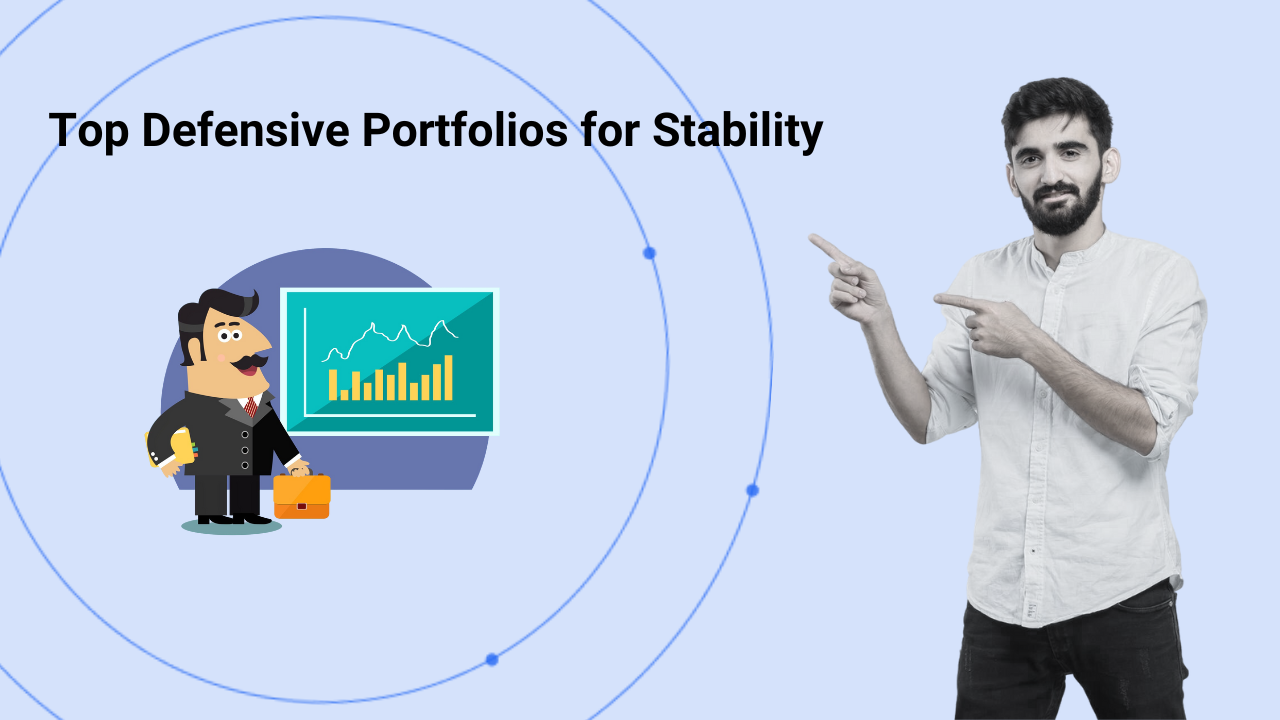In times of market uncertainty, risk-averse investors seek stability and protection for their portfolios. A defensive portfolio is designed to preserve capital and provide steady returns, even when markets experience volatility. By focusing on assets that are less sensitive to economic cycles, defensive portfolios offer a safeguard against significant losses during downturns.
In this blog, we will explore the top 3 defensive & stability portfolios for risk-averse investors in volatile markets. These portfolios are structured to help investors navigate market fluctuations while prioritising capital preservation and long-term stability.
Understanding Defensive & Stability Portfolios
A defensive portfolio is designed to weather economic downturns and market volatility while aiming to preserve capital and minimise risk. Unlike growth-oriented portfolios, which focus on maximising returns, defensive portfolios prioritise stability and steady performance. These portfolios typically consist of low-volatility assets that can provide consistent returns, even during periods of market uncertainty.
Key characteristics of a defensive portfolio include:
- Capital Preservation: The main goal is to protect your invested capital from significant losses, especially during economic corrections.
- Low Volatility: Defensive assets are less susceptible to large price fluctuations, offering investors a smoother investment journey.
- Steady Income: Many defensive portfolios include dividend-paying stocks or bonds, providing regular income even during tough market conditions.
A stable investment strategy balances the potential for returns with a focus on safety, making it an ideal choice for risk-averse investors who want to limit exposure to high-risk assets.
Top 3 Defensive Portfolios for Risk-Averse Investors
When building a defensive portfolio, it’s crucial to choose assets that align with your risk tolerance while ensuring stability and steady growth. Below are the top 3 defensive & stability portfolios for risk-averse investors seeking to protect their investments in volatile markets:
Portfolio 1: Dividend-Focused Portfolio
Dividend-paying stocks are an excellent choice for a defensive portfolio. These stocks tend to provide steady income, even when the broader market experiences downturns. The key to a successful dividend-focused portfolio is selecting companies with a strong track record of paying consistent dividends, particularly those in resilient sectors like consumer staples, utilities, and healthcare.
- Example Stocks:
- Hindustan Unilever (consumer staples)
- NTPC (utilities)
- Dr. Reddy’s Laboratories (healthcare)
- Hindustan Unilever (consumer staples)
These sectors are less impacted by economic volatility, and their steady dividends offer a reliable income stream. Over time, dividend payouts can compound, providing additional growth potential in a low-risk environment.
Portfolio 2: Safe Haven Portfolio
A safe haven portfolio is designed to protect your investments during times of extreme market stress or economic crises. This portfolio typically includes assets that are traditionally viewed as stable, such as gold, government bonds, and recession-proof stocks.
- Gold is a classic safe haven, often increasing in value when stock markets are falling.
- Government Bonds, particularly those from stable economies, provide low-risk returns.
- Recession-Proof Stocks: Companies in sectors like consumer staples and utilities, which continue to perform well during economic downturns, can also be included.
A well-balanced safe haven portfolio helps investors preserve wealth during market turbulence, ensuring capital protection when uncertainty is high.
Portfolio 3: Recession-Proof Portfolio
A recession-proof portfolio is structured to perform well even during prolonged economic slowdowns. By focusing on defensive sectors such as FMCG, healthcare, and telecommunications, this portfolio remains relatively stable when markets face corrections.
- FMCG: Stocks in this sector, such as ITC and Nestlé, are consistently in demand, regardless of market conditions.
- Healthcare: Stocks like Sun Pharma and Cipla perform steadily, as demand for medical products remains essential.
- Telecommunications: Companies like Bharti Airtel benefit from consistent demand for communication services.
This type of portfolio ensures long-term stability, making it suitable for risk-averse investors seeking to avoid the volatility typically associated with growth stocks.
Key Characteristics of Stable Investments in Volatile Markets
When constructing a defensive portfolio, it’s important to focus on stable investments that can weather market fluctuations without significant losses. The following characteristics are essential when selecting investments for stability and long-term resilience:
- Low Volatility
Stability in the form of low volatility ensures that the investment does not experience drastic fluctuations in price, even during market corrections. Stocks and assets with lower price movements are less likely to cause sudden losses, making them ideal for risk-averse investors. - Consistent Earnings or Dividends
Stable earnings or regular dividend payouts are a hallmark of resilient stocks. Companies with a history of maintaining or growing dividends—even during downturns—demonstrate financial strength and reliability, making them a solid foundation for a defensive portfolio. - Defensive Sectors
Investing in defensive sectors, such as consumer staples, utilities, and healthcare, ensures that the assets within your portfolio remain in demand, regardless of market conditions. These sectors provide goods and services that are essential, which helps maintain their stability even during recessions. - Strong Balance Sheets
Companies with strong financials—such as low debt and ample cash reserves—are better positioned to weather market downturns. Stable investments often come from companies that have a solid financial foundation, allowing them to navigate through economic volatility. - Diversification
Spreading investments across multiple defensive sectors and asset classes reduces the overall risk of the portfolio. A well-diversified defensive portfolio is more resilient to market fluctuations and can provide more consistent returns over time.
How to Strengthen Your Portfolio with Defensive Stocks
A well-structured defensive portfolio focuses on capital preservation, steady income, and long-term stability. By prioritising low-volatility assets in resilient sectors such as FMCG, healthcare, and utilities, investors can protect their wealth even during periods of market uncertainty. Combining dividend-paying stocks, recession-proof assets, and safe haven investments provides a robust framework for risk-averse investors seeking financial security.
Incorporating these strategies into your portfolio will help ensure that your investments remain resilient through market corrections and economic downturns, while still providing opportunities for growth. By leveraging well-researched insights, Streetgains can help guide you in selecting the best defensive stocks to build a stability-focused portfolio tailored to your investment goals.
Disclaimer:
The content in this blog is intended for informational purposes only and does not constitute investment advice, stock recommendations, or trade calls by Streetgains. The securities and examples mentioned are purely for illustration and are not recommendatory.
Investments in the securities market are subject to market risks. Please read all related documents carefully before investing.
Defensive & Stability Portfolios for Risk-Averse Investors FAQs:
A defensive portfolio focuses on assets that are less affected by market cycles, including economic downturns. These assets tend to be from sectors that provide essential goods or services, like consumer staples, healthcare, and utilities. A stable portfolio is designed to reduce volatility and minimise risk, ensuring that the portfolio holds value even when markets experience major corrections or recessions.
Dividend Champions are companies that have consistently paid and grown their dividends for many years, even during market downturns. These stocks are considered stable investments because they reflect the company’s financial strength and commitment to shareholder value. By providing regular income, Dividend Champions help cushion your portfolio during volatile periods, contributing to both capital preservation and long-term growth.
A Safe Haven Portfolio generally includes assets that perform well during times of economic uncertainty or market turmoil. Common assets in this portfolio include gold, government bonds, and recession-resistant stocks. These assets are historically considered low-risk and can provide capital protection when traditional stock markets are volatile. The goal is to preserve wealth and ensure stability when other investments are suffering.
Recession-proof portfolios are typically better suited for long-term investing. While they provide protection during market downturns, their structure also ensures steady, sustainable growth over time. These portfolios focus on sectors and companies that are less affected by recessions, making them ideal for risk-averse investors who seek to grow their wealth steadily without large fluctuations. Although they can offer short-term protection, their primary strength lies in long-term resilience.
Balancing growth stocks with defensive assets allows investors to enjoy the benefits of capital appreciation while also safeguarding against significant market downturns. For example, adding defensive assets like dividend-paying stocks or utilities alongside growth stocks like technology or consumer discretionary helps ensure that your portfolio remains steady during volatile periods. The key is to maintain a balance that aligns with your investment goals and risk tolerance.
Asset allocation is crucial for managing risk in any investment strategy. By diversifying your investments across various asset classes—such as stocks, bonds, commodities, and real estate—you can reduce the impact of market volatility. In a risk-averse investment strategy, a larger portion of the portfolio is allocated to low-risk assets (e.g., government bonds, defensive stocks), ensuring that it performs steadily even in turbulent times.
To identify stable investments, look for companies with a strong balance sheet, low debt, and a history of consistent earnings. Companies in defensive sectors like healthcare, utilities, and consumer staples tend to perform well during periods of economic uncertainty. Additionally, investing in dividend-paying stocks with a strong track record of growing dividends can provide both stability and a reliable income stream.
While defensive portfolios generally offer lower risk, they may not achieve the same high returns as more aggressive growth portfolios. However, this lower risk is compensated by consistent performance and capital protection, which can be crucial for risk-averse investors. The focus is on long-term stability rather than short-term high returns, ensuring that investors’ capital remains intact even during market downturns.
Yes, Streetgains provides data-backed research to help investors identify defensive stocks that align with their risk tolerance and investment goals. By using well-researched insights and strategies, Streetgains helps investors select stocks from resilient sectors, ensuring the creation of a stability-focused portfolio that can withstand market fluctuations and economic uncertainties.
FAQs:
-
1. How to earn money daily from trading?
Earning money daily from trading involves strategies like day trading, where traders capitalise on small price movements within the same day. Success requires real-time market analysis, quick decision-making, and risk management.
-
2. How to earn money from equity trading?
To earn money from equity trading, you need to buy stocks at a lower price and sell them at a higher price. Success depends on researching companies, analysing stock trends, and using technical or fundamental analysis.
-
3. How to earn money from share trading in India?
In India, share trading offers profit potential through buying and selling stocks on exchanges like the NSE and BSE. To maximise returns, traders should use market research, tools like technical analysis, and risk management strategies.
-
4. How to make money from share trading in India?
Making money from share trading involves selecting the right stocks, timing the market, and implementing trading strategies like swing trading or day trading while staying informed about market trends.
-
5. How to transfer money from a trading account to a bank account?
To transfer money from your trading account to your bank, log into your trading platform, navigate to the funds section, and initiate a withdrawal request. The money will typically be credited to your linked bank account in 1 to 3 days.
-
6. How to withdraw money from a trading account?
You can withdraw funds by logging into your trading account, selecting the withdrawal option, and selecting the amount to transfer to your bank account. Ensure your bank account is linked and follow any steps your broker requires.
Subscribe to our Credits-Based Research System:
Pay only for successful research calls!












